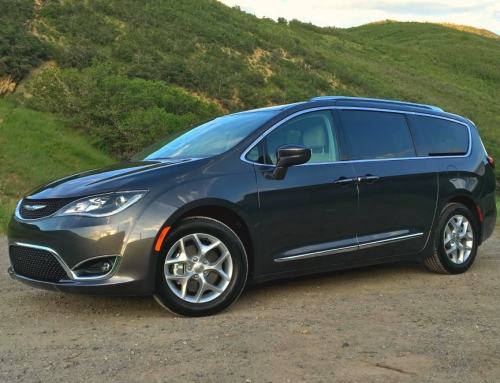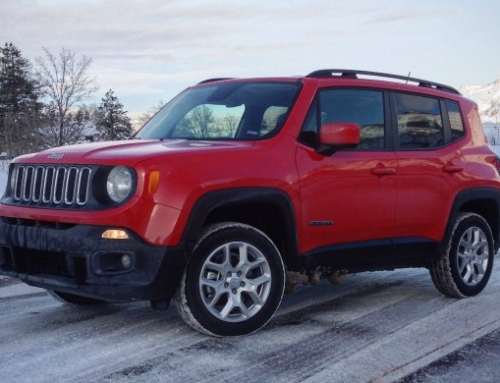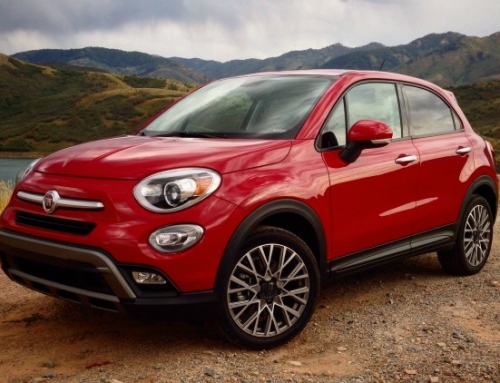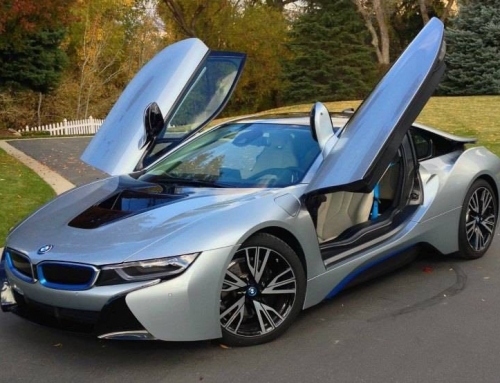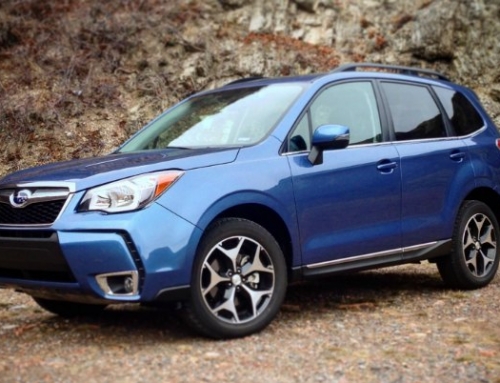Could the 2016 Subaru WRX STI unseat the WRX as my favorite Subie? A few months ago I confirmed that the WRX is my favorite Subaru thanks to its excellent mix of all-wheel drive, outstanding safety ratings and a turbocharged engine that offers plenty of power and an engaging driving experience.
This week I tested the performance-oriented 2016 Subaru WRX STI and, surprisingly, the basic WRX remains my favorite Subaru, though I’m certain track-day racers and twenty-something owners of the WRX STI will certainly disagree. Even though the WRX STI didn’t claim a spot on my favorite Subaru lists, there are still plenty of reasons why it might be your favorite. Here are five.
Reason #1: 2016 Subaru WRX STI Delivers a Bigger Engine with More Oomph
The standard WRX offers an impressive mill in its 2.0-liter turbocharged boxer direct-injected four-cylinder engine that makes 268 horsepower and 258 pound-feet of torque. For most drivers, that’s more than enough power.
Not so for WRX STI fans who require more power and more control. Where the WRX can be paired to a six-speed manual transmission or a Continuously Variable Transmission (CVT), the STI offers only a six-speed manual and that manual tranny is mated to a 2.5-liter turbocharged four-cylinder boxer engine that makes 305 horsepower and 290 pound-feet of torque.
It’s quite a bit faster than the standard WRX, too. The WRX should manage a run from 0 to 60 in just under 6 seconds. The 2016 Subaru WRX STI will cross that same space in about 5 seconds. That power is immediately obvious, especially when down-shifting from sixth gear on the highway to fourth where you can suddenly add another 20 to 30 miles per hour to your overall speed in seconds and leave surprised fellow drivers in the dust (not that I’m admitting I drove that fast, of course).
When I’ve tested the 2015 and 2016 Subaru WRX models, I’ve averaged 23.5 mpg, which essentially matches the 23 mpg in combined driving predicted by the EPA. Fuel economy takes a nosedive in the WRX STI, but that’s not unexpected. The EPA anticipates the WRX STI will return 17 mpg in city driving and 23 mpg on the highway for a combined 19 mpg. I averaged 19.5 during a week when I drove in the most spirited manner whenever possible.
Reason #2: Subaru WRX STI Design Demands Attention
One of my neighbors stopped by my house the day after the WRX STI arrived in my driveway and jokingly said, “When did ‘Hot Wheels’ start making cars you can actually drive?”
The comment made perfect sense given the fact that my test model arrived in a limited-edition Hyper Blue tint and featured the standard hood scoop and that big tail fin at the rear of the car. It looked every bit like the Hot Wheels and Matchbox cars my eight-year-old nephew adores and collects.
Today’s WRX models are only available as sedans. That’s a big change from the prior generation when a hatchback was the norm. That’s the model in which I first experienced the WRX STI and I still prefer that body style. But the sedan is obviously more compelling to buyers, having prodded significant year-over-year sales compared to prior years. In fact, the WRX is on track for its best sales year ever, nearly doubling sales of the old-style 2013 model.
Is the WRX STI’s aggressive styling right for you? Since you’re reading this article, let’s assume it is. But spend some time with the car in person before you commit, because you can certainly expect some “thumbs up” reactions from many observers and some looks of scorn from others. I observed both during my week behind the wheel and that happens with a small number of vehicles I test.
Reason #3: A Customized All-Wheel Drive System
Like nearly all Subarus, all-wheel drive is standard on the WRX STI and delivers maximum control and improved grip in wet, snowy and sandy conditions. Unlike nearly all Subarus, the WRX STI boasts a unique all-wheel-drive system that differs from the standard Symmetrical All-Wheel Drive you’ll find in most Subies. It’s called Driver Controlled Center Differential (DCCD) and it offers three driver-adjustable driving modes to match the conditions.
“Auto” is the default and will prove excellent in most settings. However, if you take the WRX STI off road or are driving on gravel or snowy surfaces, you’ll want to adjust to the Auto+ setting that tightens the limited slip differential and provides more traction. Alternatively, take your WRX STI to the track and you’ll want to use the Auto- setting that places more torque bias on the rear wheels and enhances steering feel. If that’s not enough, a manual mode allows drivers to select up to six settings that vary torque distribution from front to rear to provide optimal performance and traction.
I tested the WRX STI during a snowy week where wet, snow-covered and icy roads were the norm and the sedan handled well and felt planted in all conditions — without having to adjust the all-wheel-drive settings. But it’s always good to know that option is available if necessary.
Reason #4: Engaging but Unrefined Ride
After a week behind the wheel, the WRX STI leaves two strong impressions. First, as my friend said, “It feels like a bobcat ready to pounce at any moment.” He was referring to the live nature of the ride where you can feel what all four wheels are doing and thinking at any given time. The car dips and weaves and leaps forward with excitement when prodded. That’s a good thing if you’re looking for an engaging, dynamic ride.
That also leads to my second impression. The WRX STI is loud on the inside with a decent amount of road and wind noise entering the cabin. Plus, that active, jittery ride that is so thrilling on the track can prove taxing in daily commuting. Driving the highways, I enjoyed the power, the energy and the confidence this performance sedan imbues. But after more than an hour in stop-and-go traffic, I was ready to trade the WRX STI for a Volkswagen Golf or the slightly larger Honda Accord. Both of those cars deliver engaging driving dynamics, but they’re easier to live with on a daily basis. Plus, the interior finish of both those vehicles is superior to the WRX’s much-improved, but still lagging, interior.
Reason #5: Excellent Safety Ratings
This car has rally racing background in its blood and it’s obvious the WRX STI can take you to places and speeds most cars will rarely attempt. That extra speed and performance can also land you in trouble if you’re not careful. Good thing the 2016 Subaru WRX earned a “Top Safety Pick+” rating from the Insurance Institute for Highway Safety. That’s simply the best rating a car can earn and few vehicles are earning “Top Safety Pick+” ratings in 2016 due to increasingly demanding tests.
A rearview camera and seven airbags are standard. Subaru’s EyeSight technology is also available and recommended. You’ll be impressed by the adaptive cruise control, lane departure and sway warning, pre-collision braking and pre-collision throttle management.
Reliability is also solid, but not spectacular. Consumer Reports expects the 2016 WRX models to perform slightly below average in terms of reliability. Subaru backs owners with a three-year/36,000-mile limited warranty and a five-year/60,000-mile limited powertrain warranty.
The WRX Performance All Star
For most drivers who like Subaru WRX models, the standard WRX makes the most sense. You’ll experience a thrilling engine, an outstanding all-wheel-drive system, and excellent safety ratings. And it will cost less than the WRX STI models.
Yet, if you’re someone who demands more performance, more attention and more capability on the race or rally track, the 2016 Subaru WRX STI is the logical upgrade. My well-equipped test model started at $38,995 and included the limited-edition blue paint and the higher-end interior, plus 18-inch wheels. After a $795 destination fee, the total price was just short of $40,000. That’s nearly $8,000 more than the 2016 WRX model I tested a few months ago, but it was certainly a more performance-oriented machine.
2016 Subaru WRX STI photo copyright Waterdog Media, Inc.


